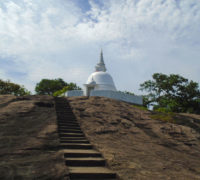Situated not very far from the heart of Colombo, about six kilometres from the Miriswatta junction is the infamous rock temple Maligathenna. It took us about one and half hours to reach our destination and as sign boards are very limited asking for directions might not be a bad idea to avoid misdirection. As they have renovated the area recently a few meters away from the original entrance is another concreted road, through which you could take your vehicle somewhat closer to the temple premises.
According to historic evidences, the Maligatenne temple runs back as far as the Anuradhapura kingdom up until the Kotte period, where ancient ministers and kings sought sanctuary from time to time. However looking at various stories that which takes prominence is of King Walagamba, who seeked refuge during the invasion of the Indian Chola Army. Thus the drip ledges carved into the caves within the temple premises and en route to the dagoba atop the mountain are regarded as that which had been done during this era.

In addition the temple is also shrouded in many legends related to the Tooth relic, where it was brought to be hidden from both Magha, an Indian Invader and during the Portuguese invasion. During the era of King Don Juan Dharmapala, who embraced Christianity, other Kings of the era such as King Mayadunna conspired to conceal the Tooth Relic in the Maligathenna Temple. When the Diyawadana Nilame of Hiripitiya was given the message to bring the Tooth Relic to the Central area of the country. The Tooth Relic rested here before being carried to Delgamuwa and then to Kandy. Thus the name of Maligathenna was derived because the premises provided a haven for the Tooth Relic.
We didn’t spend much time exploring the temple premises, as much interest was given to hiking through to the Uda Maluwa. However just before you enter the temple premises, as it was renovated recently you can’t miss the pre-historic carvings of a dog, a bird and of the sun on either side of the stairway leading up. Unfortunately as they have been painted, it has lost its original appearance. An untarnished carving could be found just before you enter the path way that leads to the Uda Maluwa as well.
The hike up to the Uda Maluwa, situated atop the mountain is what I was indeed looking forward to during this trip. It was a tedious one especially as it had rained the previous night. Therefore we encountered a few slippery areas as well as a kithul tree which thankfully had fallen atop a cave and did not bar our path upward. Ensure to take enough water and sun screen and bug spray. Also beware of snakes and meditating couples, who seems to be at every nook and corner of the place. According to many this is considered to be the highest point of the Gampaha District. At times resting, or pushing our way up grabbing on to rocks and vines, we continued our journey upward which was bordered by a few caves and stone steps at certain points.
On our journey upward, we came across a wind gap which was called Old Degaldoru Kurubil Stone steps. According to folk lore, a monk named Mittasabha, attained nirvana here. The path to the top is adorned by beautiful wild flowers. The greenery surrounding the path is definitely breath taking, thus ensure to take as less plastic and other pollutants on your journey, ensuring that we safeguard and leave unharmed the natural beauty and bio diversity of the premises.
Closer to the summit we were greeted by a panoramic view which was beautiful. Etched in stone, a flight of steps led us up to the Uda Malwa, where the scenic view was filled with every colour and more of green on a colour palatte. Situated atop is a small Dagoba and the infamous ancient rock pond. It is said that despite the any form of dry weather the pond never runs dry. We also encountered colourful and rare butterflies some as big as your hand fluttering by. Although it was a strenuous climb the panoramic vista was indeed completely worth it.
